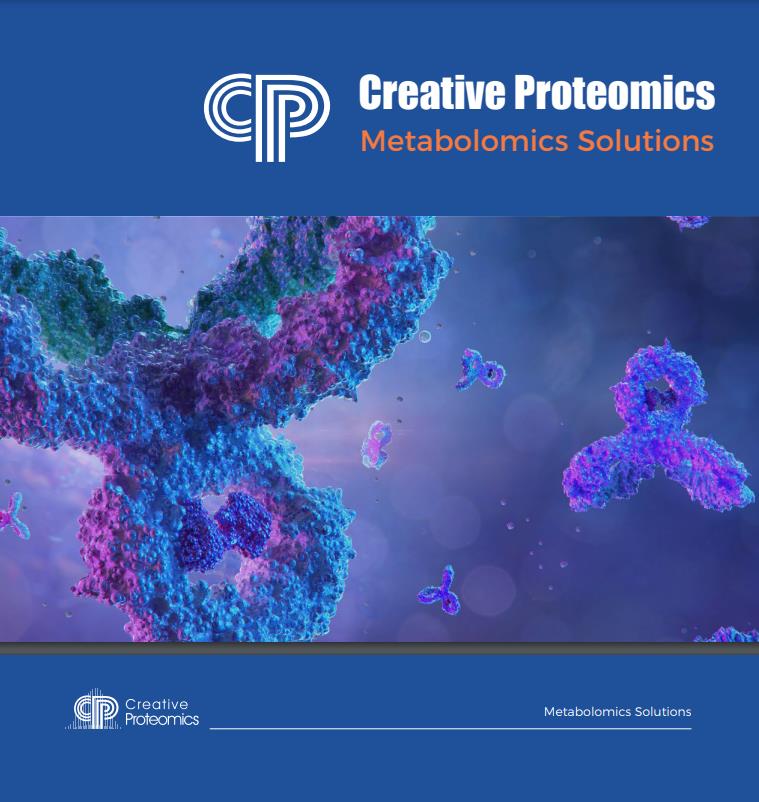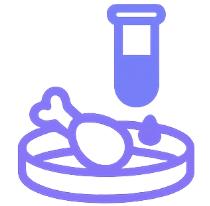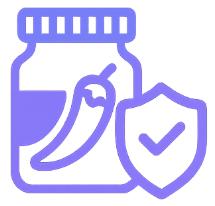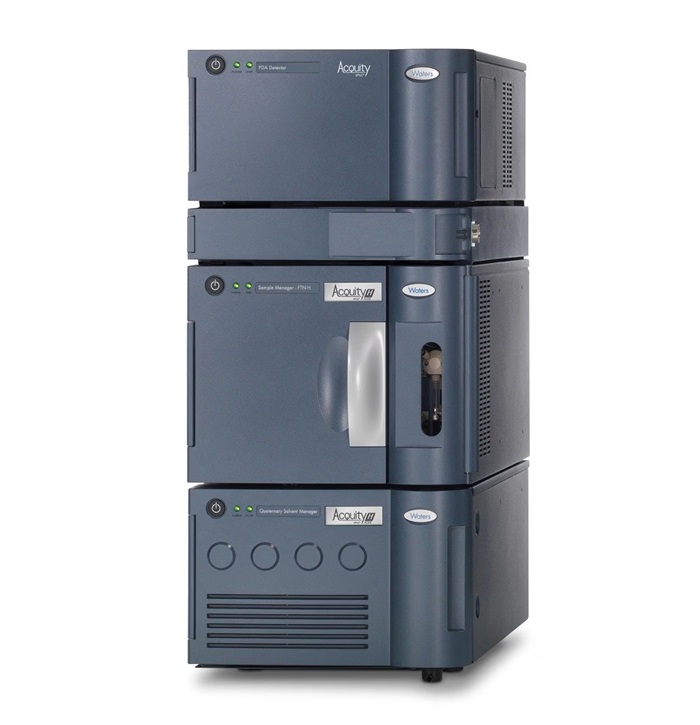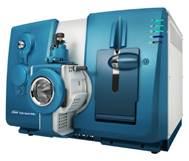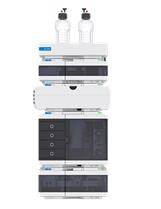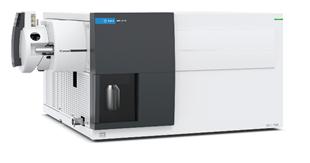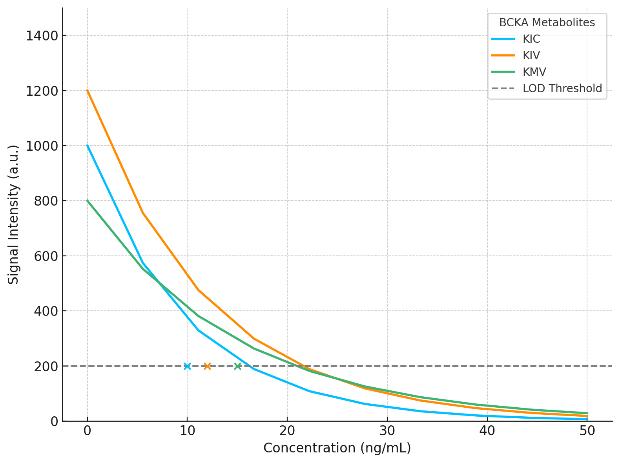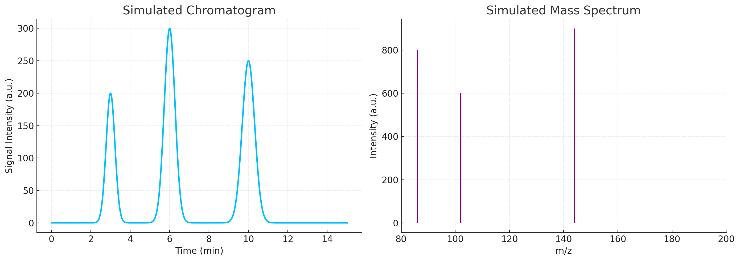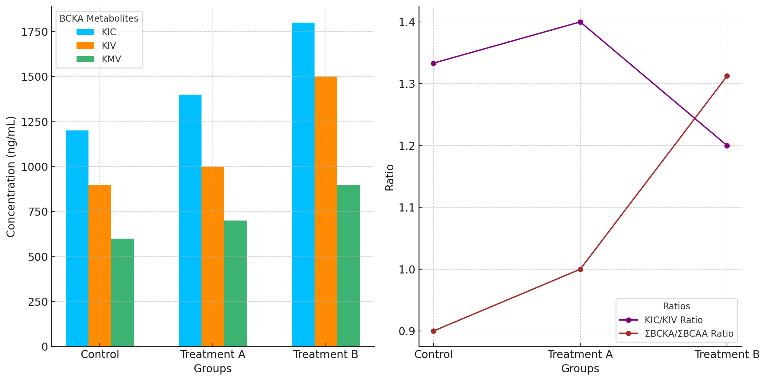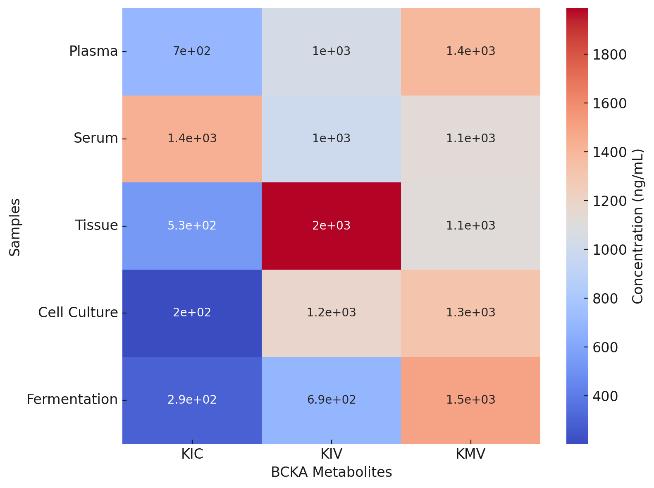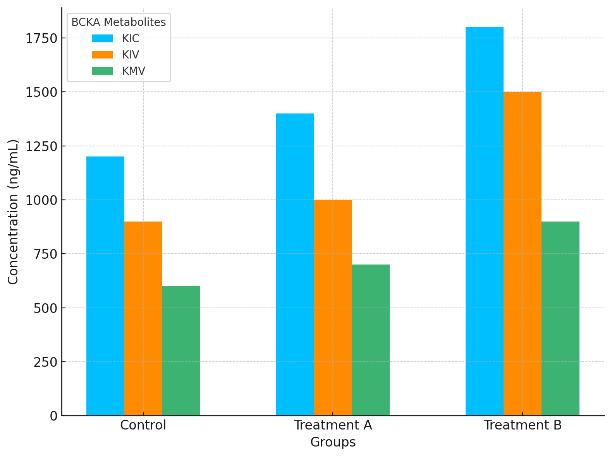What Are BCKAs and Why Measure Them?
Branched-chain keto acids (BCKAs) are the first oxidative deamination products of branched-chain amino acids (BCAAs: valine, leucine, isoleucine). Transamination by BCAT yields three principal BCKAs:
- α-ketoisocaproate (KIC) from leucine
- α-keto-β-methylvalerate (KMV) from isoleucine
- α-ketoisovalerate (KIV) from valine
Because BCKAs sit immediately upstream of the branched-chain α-keto acid dehydrogenase (BCKDH) complex, their absolute and relative concentrations are sensitive indicators of BCAA transamination, BCKDH activity, mitochondrial redox status, and peroxisomal/mitochondrial interplay. Accurate BCKA profiling helps you:
- Map BCAA catabolic flux and pathway bottlenecks.
- Evaluate nutritional interventions and metabolic engineering strategies.
- Monitor cell culture performance in bioprocessing where BCAA utilization affects growth and by-products.
- Build and validate mechanistic models of energy metabolism using quantitative, matrix-matched data.
What Problems We Solve for Our Clients
What We Offer — BCKA Panel Services
- Targeted BCKA Quantitation (Core Panel): KIC, KMV, KIV.
- Extended Keto-/Hydroxy-acid Panel (Optional): α-hydroxyisocaproate (HICA), β-hydroxy-β-methylbutyrate (HMB), α-hydroxyisovalerate (HIVA), α-hydroxy-β-methylvalerate (HMV).
- Context Metabolites (Optional): BCAAs (Leu/Ile/Val), C5 acylcarnitines (isovaleryl-, 2-methylbutyryl-, isobutyryl-carnitine), selected TCA intermediates.
- Stable-Isotope Dilution: 13C/2H-labeled analogs for each BCKA when available; class-specific surrogates otherwise.
BCKA Panel and Related Analytes (Measured/Optional)
| Group |
Analyte (Abbrev) |
Synonyms |
Reporting Range (ng/mL) |
Internal Standard |
Stability Notes |
| Core BCKAs |
α-Ketoisocaproate (KIC) |
4-methyl-2-oxopentanoate |
2 – 5,000 |
13C-KIC |
Sensitive to oxidation; freeze promptly |
| |
α-Ketoisovalerate (KIV) |
3-methyl-2-oxobutyrate |
2 – 5,000 |
13C-KIV |
Stable at −80 °C; avoid >2 freeze-thaws |
| |
α-Keto-β-methylvalerate (KMV) |
3-methyl-2-oxopentanoate |
2 – 5,000 |
13C-KMV |
Light-sensitive; ship on dry ice |
| Derived Hydroxy-/Keto-Acids |
α-Hydroxyisocaproate (HICA) |
2-hydroxy-4-methylpentanoate |
5 – 10,000 |
13C-HICA |
Stable under frozen storage |
| |
β-Hydroxy-β-methylbutyrate (HMB) |
3-hydroxy-3-methylbutyrate |
5 – 10,000 |
13C-HMB |
Stable; widely studied in sports nutrition |
| |
α-Hydroxyisovalerate (HIVA) |
2-hydroxy-3-methylbutyrate |
5 – 10,000 |
Surrogate |
Stable at −80 °C |
| |
α-Hydroxy-β-methylvalerate (HMV) |
2-hydroxy-3-methylpentanoate |
5 – 10,000 |
Surrogate |
Less common; include if KMV studied |
| |
2-Oxoisocaproylglycine |
KIC conjugate |
10 – 50,000 |
Surrogate |
Conjugated form; useful in excretion studies |
| |
2-Oxoisovaleroylglycine |
KIV conjugate |
10 – 50,000 |
Surrogate |
Same as above |
| Context Amino Acids |
Leucine (Leu) |
— |
10 – 100,000 |
13C-Leu |
Stable frozen |
| |
Isoleucine (Ile) |
— |
10 – 100,000 |
13C-Ile |
Stable frozen |
| |
Valine (Val) |
— |
10 – 100,000 |
13C-Val |
Stable frozen |
| Context Acylcarnitines |
Isovalerylcarnitine (C5-IV) |
— |
1 – 2,000 |
2H-C5 |
Stable if stored −80 °C |
| |
2-Methylbutyrylcarnitine (C5-MB) |
— |
1 – 2,000 |
2H-C5 |
Stable frozen |
| |
Isobutyrylcarnitine (C4-IB) |
— |
1 – 2,000 |
2H-C4 |
Stable frozen |
| |
Propionylcarnitine (C3) |
— |
1 – 2,000 |
2H-C3 |
Stable frozen |
| |
Butyrylcarnitine (C4) |
— |
1 – 2,000 |
2H-C4 |
Stable frozen |
| Related Organic Acids |
Succinyl-CoA (proxy via succinate) |
— |
Variable |
Surrogate |
Proxy for downstream entry to TCA |
| |
Methylmalonic acid (MMA) |
— |
5 – 10,000 |
2H-MMA |
Sensitive; monitor B12-related flux |
Why Choose Our BCKA Analysis Service: Key Advantages
- Sensitivity: Method LLOQs as low as 2 ng/mL for KIC/KIV/KMV in protein-precipitated plasma using LC–MS/MS with derivatization; ≤5 ng/mL in non-derivatized workflows.
- Linearity: Weighted 1/x or 1/x² calibration with R² ≥ 0.995 over 3–4 orders of magnitude, matrix-matched.
- Precision & Accuracy: Intra-assay CV ≤10%, inter-assay CV ≤15%; mean bias within ±10% across QC levels.
- Recovery & Matrix Effects: Absolute recovery typically 80–110%; ion suppression/ enhancement corrected via stable-isotope dilution and post-extraction spiking.
- Carryover Control: Analyte carryover maintained <0.1% of low-cal calibrators with programmed needle wash and diversion valves.
- Stability Provenance: Freeze–thaw stability within ±15% across ≥3 cycles; short-term bench stability established for each matrix/derivative chemistry.
- Traceable Quantitation: Calibration traceability to NMI-linked reference materials or in-house characterized stocks with documented purity assessment.
Key Instrument Platforms for Accurate BCKA Panel Quantification
Creative Proteomics applies targeted LC–MS/MS as the primary platform, with GC–MS/MS as an orthogonal option for confirmation or special matrices.
- LC–MS/MS (Main Approach):
Using UHPLC systems coupled with high-sensitivity triple quadrupoles, α-keto acids are stabilized through derivatization (e.g., 3-NPH), quantified with isotope-labeled internal standards, and measured in scheduled MRM mode to ensure selectivity and reproducibility.
- GC–MS/MS (Complementary):
Used for confirmation of certain organic acids or for legacy comparability, applying derivatization to enhance volatility and sensitivity.
Key advantages for clients:
- High sensitivity (LLOQ down to ~2 ng/mL for BCKAs).
- Robust quantitation with isotope dilution calibration.
- Flexibility to adapt workflows across plasma, serum, tissue, cells, fermentation broth, and formulated products.
How Our BCKA Panel Assay Works — Step-by-Step Process
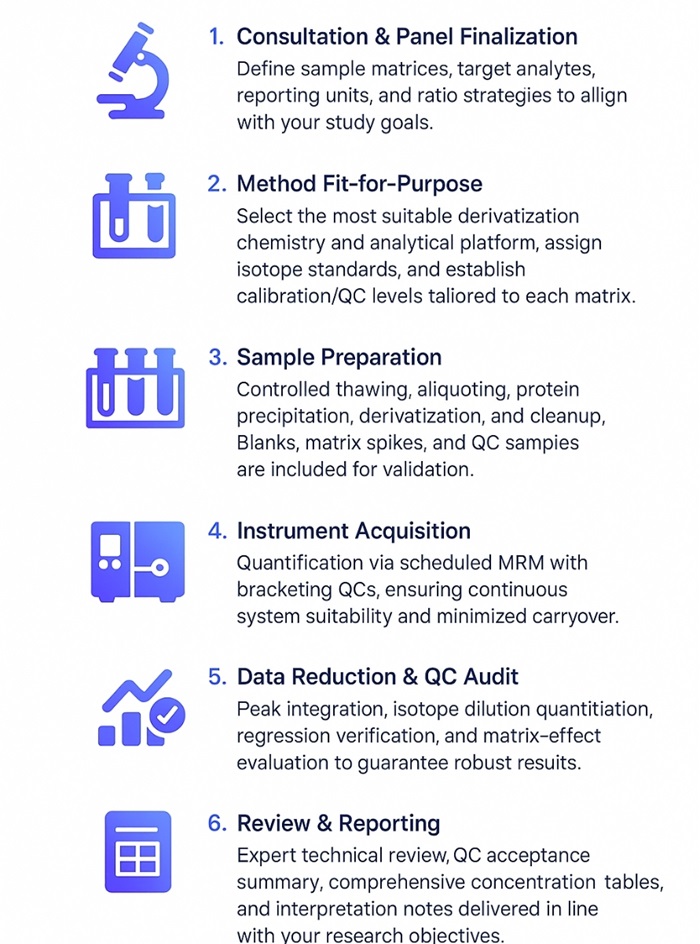
Sample Requirements for BCKA Panel
| Matrix |
Preferred Container |
Minimum Amount |
Pretreatment Notes |
Storage & Shipping |
| Plasma/Serum |
Polypropylene cryovial |
80–150 µL per replicate |
EDTA or heparin; avoid citrate for carboxylate analysis |
Freeze ≤ −70 °C; ship on dry ice |
| CSF |
Polypropylene cryovial |
80–150 µL |
Handle low protein carefully; avoid repeated thaw |
Freeze ≤ −70 °C; ship on dry ice |
| Tissue |
Cryovial / tube with beads |
≥ 20 mg (wet) |
Snap-frozen; we homogenize under cold organic solvent |
Keep frozen; ship on dry ice |
| Cultured Cells |
Pellet in cryovial |
≥ 1×10^6 cells |
Wash with cold PBS; quench and pellet rapidly |
Keep frozen; ship on dry ice |
| Culture Media / Fermentation Broth |
Plastic vial |
≥ 300 µL |
Record formulation; filter particulates if possible |
Chill or freeze; ship cold/frozen |
| Formulated Products / Nutritional Materials |
Plastic vial |
≥ 200 mg or ≥ 300 µL |
Provide ingredient list for interferences check |
Protect from light; ship cold/frozen |
Deliverables: What You Receive from Our BCKA Analysis
- Certificate of Analysis (RUO): Analyte list, method synopsis, calibration model, reportable ranges.
- Concentration Tables: Absolute values and optional ratios (e.g., KIC/KIV, ΣBCKA/ΣBCAA) in your requested units.
- QC & Method Performance Summary: Linearity, precision, accuracy, recovery, and matrix-effect data for the batch.
- Chromatograms & Spectra: Representative MRM traces; retention-time windows and qualifiers.
- Raw Data Package: Vendor files and processed exports (mzML, CSV/XLSX) to enable re-analysis.
- Study Notes: Any observed interferences, out-of-trend samples, or recommendations for follow-up.
Comparative Metabolite Profiling of Salt Sensitive Oryza sativa and the Halophytic Wild Rice Oryza coarctata under Salt Stress
Tamanna, N., Mojumder, A., Azim, T., Iqbal, M. I., Alam, M. N. U., Rahman, A., & Seraj, Z. I.
Plant‐Environment Interactions
Year: 2024
Physiological, Transcriptomic and Metabolomic Insights of Three Extremophyte Woody Species Living in the Multi-Stress Environment of the Atacama Desert
Gajardo, H. A., Morales, M., Larama, G., Luengo-Escobar, A., López, D., Machado, M., … Bravo, L. A.
Planta
Year: 2024
Untargeted Metabolomics Reveal Sex-Specific and Non-Specific Redox-Modulating Metabolites in Kidneys Following Binge Drinking
Rafferty, D., de Carvalho, L. M., Sutter, M., Heneghan, K., Nelson, V., Leitner, M., … Puthanveetil, P.
Redox Experimental Medicine
Year: 2023
Ketone Bodies Are Mildly Elevated in Subjects with Type 2 Diabetes Mellitus and Are Inversely Associated with Insulin Resistance as Measured by the Lipoprotein Insulin Resistance Index
Garcia, E., Shalaurova, I., Matyus, S. P., Oskardmay, D. N., Otvos, J. D., Dullaart, R. P., & Connelly, M. A.
Journal of Clinical Medicine
Year: 2020

